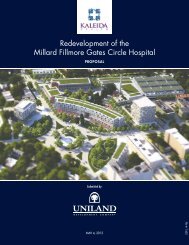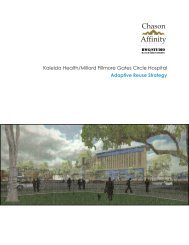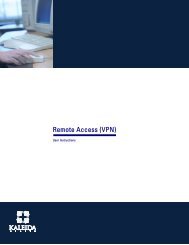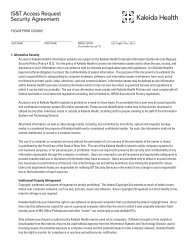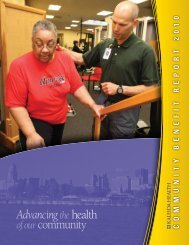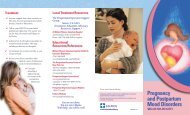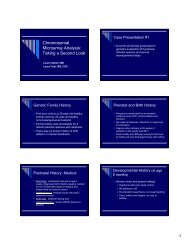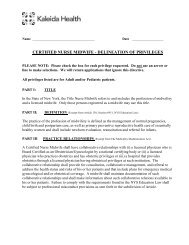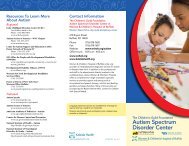View Presentation Document - Kaleida Health
View Presentation Document - Kaleida Health
View Presentation Document - Kaleida Health
You also want an ePaper? Increase the reach of your titles
YUMPU automatically turns print PDFs into web optimized ePapers that Google loves.
A Cool Therapy for HIE<br />
It’s s Here! A Cool Therapy<br />
for Neonatal Brain Injury<br />
Corinne L. Leach, MD, PhD<br />
Women and Children’s s Hospital of<br />
Buffalo<br />
Grand Rounds<br />
July 25, 2008<br />
I. Case Report<br />
II. Extent of the Problem<br />
III. Definitions and Diagnosis of HIE<br />
IV. Pathophysiology of HIE<br />
V. Conventional management<br />
VI. New Therapies for HIE<br />
Phenobarbital<br />
Room air resuscitation<br />
Brain Cooling<br />
VII. Quality Improvement at WCHOB NICU<br />
Continuous Video EEG<br />
Delivery Room O2O<br />
blenders<br />
Systemic Hypothermia<br />
Case Report<br />
• Baby SS was a 2.6 kg AGA product of a 35 1/7<br />
weeks gestation to a 41 yo healthy G4P1 female<br />
with an uncomplicated pregnancy until she<br />
presented by ambulance to an outlying hospital<br />
with severe abdominal pain and fetal bradycardia.<br />
Delivered by stat C/S at which time placental<br />
abruption was noted.<br />
• DR: apneic, , HR<br />
Gasping respirations at 4min of life.<br />
Apgars 1,4,4 @ 1,5,10 min; no spont movement<br />
until 30 min of life.<br />
• Outside hospital course<br />
• Hand-bagged ventilation with 100% O2<br />
• UVC, UAC placed, 20 ml/kg NSS<br />
• Seizure onset at 1h of life – 20 mg/kg phenobarbital<br />
• Oozing blood noted – PT/PTT/Fibrinogen obtained<br />
• ABG at 1.5h of life: 7.03/24/173/-23<br />
23<br />
• Serum glucose 163 mg/dl<br />
• Partial correction with 2 mEq/kg NaHCO3 during transport<br />
• Arrival at WCHOB NICU<br />
• Neuro exam: no spontaneous breathing,<br />
decreased tone and reflexes; gag present<br />
• Cardiovascular: no murmur, adequate pulses, BP<br />
52/24, HR 160<br />
• Temp 36.6ºC<br />
• Labs<br />
• Na 133; BUN 19, Cr 1.5; INR 2.12; Hct 41.1; plt<br />
179K, AST 315, ALT 48<br />
• WCHOB Course<br />
• HIE – no spontaneous respiratory x 24h; vent<br />
x72h; no spontaneous movement x 36h<br />
• Metabolic Acidosis – persistent for 3h<br />
• Coagulopathy - FFP 30/kg over first 24h<br />
• Glucose instability<br />
• Seizures – initial EEG mildly depressed<br />
background; normal D3
II. Extent of Problem<br />
Acute Perinatal Hypoxic-Ischemic<br />
Encephalopathy<br />
• Postasphyxial encephalopathy<br />
• Incidence: 2-32<br />
3 infants per 1000 live term births in developed<br />
countries<br />
• *Unchanged over last 20 years<br />
• Moderate HIE<br />
• Mortality: 10%<br />
• Permanent Disability: 30% of survivors<br />
• Severe HIE<br />
• Mortality: 60%<br />
• Permanent Disability: up to100% of survivors<br />
**Up to 30% of CP due to perinatal HIE<br />
WCHOB Perinatal<br />
Regional Referral Center<br />
NICU<br />
• HIE Incidence<br />
• Outborn and inborn: 16 infants per year on average<br />
• Range 12-24 24 per year<br />
• WNY total birth rate: 16,000/yr<br />
• 131 infants with moderate to severe HIE admitted to<br />
WCHOB 2002-2008<br />
2008<br />
III. Diagnosis of HIE<br />
• Criteria<br />
• Pertinent obstetric event<br />
• (e.g. uterine rupture, abruption, cord prolapse, , maternal<br />
hemorrhage)<br />
• Measures of impaired placental gas exchange<br />
• (e.g. cord pH)<br />
• Poor adaptation at birth and need for resuscitation<br />
• (e.g. low Apgar scores)<br />
• Clinical encephalopathy<br />
• (e.g. low Sarnat scores)<br />
• Other organ system dysfunction<br />
Severity of Perinatal Asphyxia<br />
• Initial Markers of Severity<br />
• Neurologic exam – Sarnat classification, EEG<br />
background pattern<br />
• Degree of metabolic acidosis and time to<br />
correction<br />
• Cord gas and early infant blood gases<br />
• Degree of other organ involvement<br />
• renal compromise<br />
• transaminase elevation<br />
• cardiogenic shock<br />
Sarnat Classification of HIE<br />
• Sarnat I (Mild)<br />
• hyper-alert, staring, irritability, apnea, hypotonia; ; no<br />
seizures<br />
• Sarnat II (Moderate)<br />
• depressed consciousness, lethargy, hypotonia, , seizures<br />
• Sarnat III (Severe)<br />
• stupor, flaccid, unresponsive, decerebrate; ; seizures<br />
uncommon
EEG in Infant with Severe HIE<br />
Multi-system Organ Injuries<br />
Vulnerabilit<br />
y<br />
Clinical <strong>Presentation</strong><br />
Recoverability<br />
Brain ++++ Apnea, Hypotonia, Encephalopathy, Coma,<br />
+<br />
Sz<br />
Kidneys +++ Acute Renal Failure +++<br />
Lungs +++ PPHN, ALI, ARDS ++++<br />
Liver ++ Transaminase Derangement, Coagulopathy ++++<br />
Heart ++ Cardiogenic Shock, Valvular Regurgitaiton ++++<br />
Heme ++ Thrombocytopenia, DIC ++++<br />
Vascular ++ SIRS, capillary leak, sclerema ++++<br />
GI Tract ++ Feeding Intolerance, NEC ++++<br />
IV. Pathophysiology of HIE<br />
Brain Responses to Perinatal Asphyxia<br />
Shankaran, Clin Ob Gyn 2007;<br />
Lorek, Pediatr Res 1994<br />
1º Energy Failure: ↓cerebral blood<br />
flow and O 2 /substrates<br />
↓ATP<br />
Tissue acidosis<br />
Acute intracellular<br />
derangements<br />
2º Energy Failure: ↑cerebral blood flow<br />
and O 2 /substrates (reperfusion injury<br />
↓ATP<br />
NO tissue acidosis<br />
Acute intracellular<br />
derangements
Regional Patterns of Hypoxic-<br />
Ischemic Brain Injury<br />
Progression of neuronal injury or loss in<br />
term infant with HIE. T1-weighted images<br />
Vulnerable (damage associated with Sarnat II)<br />
• Cerebral Cortex<br />
• Subcortex and White Matter<br />
• Deep Central Brain – Thalamus, Caudate Nucleus, Internal Capsule<br />
• Basal Ganglia<br />
• Hippocampus<br />
• Vulnerable<br />
• More Resistant (damage associated with<br />
• Brainstem<br />
(damage associated with Sarnat III)<br />
• Very Resistant (damage associated with death)<br />
• Midbrain<br />
• Cerebellum<br />
5 days 18 days 18 days<br />
7 months<br />
Increased high signal Abnormal highlighting of the<br />
Diffuse high signal intensity<br />
intensity with low signal cortex superiorly with<br />
Persistent abnormal high signal<br />
throughout the basal<br />
cystic components. abnormal low signal intensity intensity in the thalami and<br />
ganglia and thalami.<br />
consistent with infarction in lentiform nuclei. Considerable<br />
Normal white matter<br />
the subcortical white matter white matter atrophy.<br />
appearance.<br />
Rutherford, j.earlhumdev 2005<br />
Supportive Intensive Care<br />
V. Conventional Management of<br />
the Term Infant with HIE<br />
• Correction of Hemodynamic and Pulmonary<br />
Disturbances<br />
• Hypotension – pressor, inotrope support<br />
• Metabolic acidosis – NaHCO 3 if needed<br />
• Capillary leak/ SIRS – colloid support, steroids, free<br />
water restriction<br />
• Hypoventilation/Apnea – IMV support<br />
• PPHN – Nitric Oxide<br />
Supportive Intensive Care<br />
• Correction of Metabolic and Electrolyte<br />
Disturbances<br />
• Hypoglycemia, Hypocalcemia, Hyponatremia<br />
• Correction of Hypothermia<br />
• Warmer with servo-control to 37ºC<br />
VI. New Therapies for HIE<br />
• Treatment of Seizures<br />
• Phenobarbital, EEG<br />
• Monitoring for Liver and Renal Dysfunction<br />
• LFT’s, , renal ultrasound, lytes, , BUN/Cr
HIE Pharmacotherapy<br />
• Phenobarbital 40 mg/kg<br />
• 31 infants moderate-severe HIE – randomized<br />
• seizure incidence<br />
• Phenobarbital– 9/15<br />
• Control – 14/16<br />
• 3 year normal neurodevelopmental outcome<br />
• Phenobarbital – 11/15<br />
• Control – 3/16<br />
• Hall, J Pediatr 1998<br />
Brain Cooling<br />
Nature’s s Evidence for Hypothermia<br />
Neuroprotection<br />
• Natural cooling occurs in asphyxiated infant:<br />
hypothalamus suppressed by encephalopathy<br />
• Asphyxiated newborns have decreased temperature to 34.5ºC<br />
within 2h of birth<br />
• (2ºC C less than non-asphyxiated newborns)<br />
Burnard 1958<br />
• Infants of “difficult deliveries” unable to generate heat as well<br />
as infants that had no difficulty<br />
Brück<br />
1961<br />
• Infants given GA require active warming compared with<br />
children and adults<br />
Plattner 1997<br />
Experimental Evidence for<br />
Hypothermia Neuroprotection<br />
• Animal Studies<br />
• Animal models of brain ischemia: reduction in brain<br />
temp by 2-5ºC 2 C offers neuroprotection – 1987-1998<br />
1998<br />
• Favorable effect on multiple pathways contributing to<br />
brain injury<br />
• Excitatory amino acids - Thoresen, Neuroreport 1997<br />
• Cerebral energy state - Thoresen, Pediatr Res 1995<br />
• Cerebral blood flow and metabolism – Baldwin, Am J Physiol 1991<br />
• Nitric oxide production - Thoresen, Neuroreport 1997<br />
• Apoptosis – Edwards, Biochem Biophys Res Commun 1995<br />
Adult Hypothermia Therapy<br />
• Used in head trauma, stroke, and cardiac<br />
arrest<br />
Potential Complications of<br />
Therapeutic Hypothermia<br />
• Cold-injury syndrome Culic<br />
Culic, , Arch Med Res 2005<br />
• Sclerema<br />
• Multi-system organ damage<br />
• pulmonary hemorrhage, renal failure, DIC<br />
• Hypovolemia<br />
• Glucose instability<br />
• PPHN
Potential Complications of<br />
Therapeutic Hypothermia<br />
• Bradycardia, arrhythmia<br />
• Hypertension<br />
• Major venous thrombosis<br />
• Refractory hypotension<br />
• Sepsis<br />
• Hypotension with rapid re-warming<br />
Brain Cooling Trials in Infants with<br />
HIE<br />
• Randomized controlled clinical trials<br />
• Total body cooling<br />
• Single center pilots – Azzoparti, , Pediatrics 2000; Shankaran,<br />
Pediatrics 2002; Debillion, , Dev Med Child Neurol 2003<br />
• Multi-center pilots – Eicher, , 2005<br />
• Multi-center<br />
– Shankaran, , NICHD 2005<br />
• Multi-center<br />
– TOBY, UK pending 2008<br />
• Cooling Cap (Plus mild systemic hypothermia)<br />
• Single center pilots – Gunn, 1998; Thoresen, , Pediatrics 2000;<br />
• Multi-center<br />
- CoolCap – Gluckman, , 2005<br />
Cooling Cap<br />
Total Body Cooling<br />
Time (min) Laptook, Pediatrics 2001<br />
Time (min)<br />
Laptook, Pediatrics 2001<br />
NICHD Trial<br />
• Initial Screening<br />
• ≥36 weeks gestation<br />
• Admitted to NICU ≤6h of life<br />
• Poor respiratory effort at birth and need for<br />
resuscitation<br />
or<br />
• Diagnosis of HIE<br />
NICHD Trial<br />
• Eligibility Criteria<br />
• pH ≤ 7.0 or BE ≥ -16<br />
mmol/l within 1h of life<br />
OR<br />
• pH 7.01 to 7.15, or BE -15 to 10 mmol/l within 1h of life<br />
or blood gas not available<br />
AND<br />
• Acute perinatal event including late or variable decels,<br />
cord prolapse, , cord rupture, uterine rupture, maternal<br />
trauma, hemorrhage, or cardiorespiratory arrest<br />
AND<br />
• Either Apgar ≤ 5 @10min or assisted ventilation at birth<br />
and continued for ≥ 10 min
• Inclusion Criteria<br />
NICHD Trial<br />
• Infants who met above criteria<br />
AND<br />
• Presence of moderate or severe encephalopathy<br />
according to table<br />
Criteria for Moderate and Severe HIE<br />
Category<br />
Level of<br />
consciousness<br />
Spontaneous activity<br />
Posture<br />
Tone<br />
Primitive reflexes<br />
Suck<br />
Moro<br />
Autonomic<br />
Pupils<br />
Heart rate<br />
Respiration<br />
Moderate<br />
Lethargic<br />
Decreased<br />
Distal flexion, full<br />
extension<br />
Hypotonia (focal or<br />
general)<br />
Weak<br />
Incomplete<br />
Constricted<br />
Bradycardia<br />
Periodic breathing<br />
Severe Encephalopathy<br />
Stupor/coma<br />
No activity<br />
Decerebrate<br />
Flaccid<br />
Absent<br />
Absent<br />
Deviated/dilated/non-reactive<br />
Unstable<br />
Apnea<br />
NICHD, NEJM 2005<br />
Whole Body Hypothermia Trial<br />
Whole Body Hypothermia Trial<br />
Shankaran, NICHD, NEJM 2005<br />
Shankaran, NICHD, NEJM 2005<br />
Whole Body Hypothermia Trial<br />
Whole Body Hypothermia Trial<br />
Shankaran, NICHD, NEJM 2005<br />
Shankaran, NICHD, NEJM 2005
Summary of Deaths and Survivor Outcomes<br />
in Hypothermia Trials<br />
18-22 Month Outcomes: Hypothermia Trials<br />
(n) = %; MDI @ 18-22 months<br />
Shankaran, Clin Ob Gyn 2007<br />
(n)=%; Visual impairment = blindness<br />
Shankaran, Clin Ob Gyn 2007<br />
Hypothermia – Bottom Line<br />
• 2 large randomized controlled trials of<br />
therapeutic hypothermia for term newborns<br />
with mod-severe perinatal HIE<br />
• ↓ combined outcomes of death and ND<br />
disability<br />
• Few adverse effects – mild and transient<br />
Support for Hypothermia as<br />
Standard of Care<br />
• AAP Committee on Fetus and Newborn and the<br />
NICHD - 2006<br />
• “…institutions who use hypothermia should employ a<br />
rigorous protocol, data collection, and<br />
neurodevelopmental F/U…”<br />
• Perlman, Pediatrics 2008<br />
• “It is time to stop postponing the decision to accept<br />
hypothermia (at experienced centers that use established<br />
protocols) as an effective treatment. It is our duty to<br />
explain the benefits and unknowns of cooling and to offer<br />
this treatment to every eligible patient with moderate to<br />
severe neonatal HIE.”<br />
• NICHD: National Institute of Child <strong>Health</strong> and Human Development<br />
VII. Quality Improvement at WCHOB<br />
Perinatal Regional Referral Center<br />
NICU QI: How can we improve<br />
the outcome of the infant with<br />
HIE?<br />
• New at WCHOB<br />
• Continuous Video EEG<br />
• Aspen room; remote 24h monitoring on V7<br />
• $42,000 September to Remember NICU Fundraising Event<br />
• Co-chaired by Dr. Reynolds and NICU parents<br />
• Oxygen blenders purchased for every DR<br />
• Enables resuscitation with optimal O 2<br />
• Brain Cooling<br />
• Passive hypothermia on transport<br />
• Total Body Cooling in the NICU
WCHOB Regional<br />
Perinatal Referral Center<br />
• Total body cooling<br />
• Phase I: Initiation of passive cooling at referring site<br />
• Turn off warmer in DR and nursery<br />
• Phase II: Arrival of transport team<br />
• Transport in unheated isolette<br />
• Consider cool packs<br />
• Phase III: Arrival at WCHOB NICU<br />
• Place on cooling blanket for 72h<br />
Appreciation to Drs. Vasanth Kumar and Vivien Carrion



